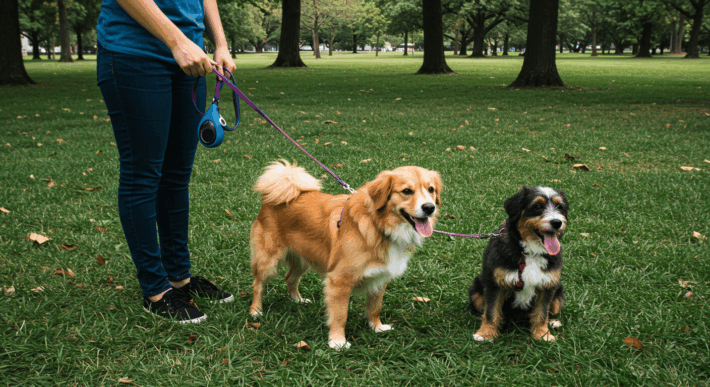Pawsitive Impact: The Rewards of a Career in Professional Dog Training

There’s a moment that every dog trainer lives for. It’s not a dramatic, movie-style transformation. It’s small. It’s the instant a frantic, pulling puppy finally loosens the leash and looks up at their owner. It’s the quiet click of understanding when a fearful, rescue dog realizes that a hand reaching out means a gentle pat, not a threat. It’s the joyful bark when a dog successfully completes an agility course for the first time.
In that moment, you see it. You’re not just teaching a dog to “sit” or “stay.” You are building a bridge of communication between a human and an animal. You are strengthening a bond, solving problems, and, in many cases, keeping a dog in its forever home. This is the profound, “pawsitive” impact of a career in professional dog training.
While the market for pet services is booming, training holds a special place. It’s foundational. Good training enriches every other aspect of a dog’s life, from a stress-free vet visit to a happy day at daycare. If you’re looking for a career with deep, tangible rewards, here’s why dog training might be your calling.
1. You Are a Translator
Dogs don’t speak English, and humans don’t speak “bark.” A huge part of your job is to act as an interpreter. You teach the human how to read their dog’s body language. Why is his tail tucked? What does that lip lick mean?
You also teach them how to give clear, consistent cues that the dog can understand. Most “badly behaved” dogs aren’t bad at all; they’re just confused. They’re living in a human world with a complex set of rules they don’t understand. When you give their owner the tools to communicate effectively, you bring clarity and harmony to the relationship. The relief on both sides is palpable.
2. You Are a Problem Solver
Every new client comes to you with a puzzle. A German Shepherd with separation anxiety. A Beagle that barks incessantly. A terrier that is reactive to other dogs on walks.
Your job is to be a detective. You have to assess the situation, understand the root cause of the behavior (is it fear, boredom, lack of exercise, or something else?), and then develop a customized training plan. This could involve:
- Group Classes: For common needs like puppy socialization or basic obedience.
- Private, One-on-One Sessions: To tackle more specific or severe behavioral issues.
- Specialized Courses: You might run fixed-date puppy classes over several weeks or offer rolling classes for ongoing skill development.
When your plan works, and the owner calls you to say, “We had our first peaceful walk in six months,” the sense of accomplishment is immense.
3. You Are a Lifesaver
This sounds dramatic, but it’s true. Behavioral problems are one of the leading reasons why dogs are surrendered to shelters. A dog that jumps on guests, destroys furniture, or shows aggression can put an immense strain on a family.
As a trainer, you are often the last hope for these families. By providing them with management strategies and training techniques, you can often turn the situation around. You are not just saving the dog’s place in the home; you are preserving a family bond. There is no greater reward than knowing your work kept a dog out of a shelter.
Anecdote Corner: A trainer I know worked with a family who was on the verge of rehoming their beautiful but incredibly destructive young Husky. The trainer realized the dog wasn’t “bad”; he was profoundly bored. She created a plan that included more intense exercise, puzzle feeders, and scent work games. Two months later, the family sent her a picture of the Husky snoozing peacefully on the rug. The caption read, “You didn’t just train our dog; you saved our family.”
4. You Get to Witness Joy Every Day
Dog training isn’t all serious problem-solving. A huge part of it is about teaching fun things and building confidence. Seeing a timid dog blossom in an agility class, or a goofy Labrador proudly retrieving a ball, is pure joy.
You get to be part of the best moments in a dog’s and owner’s life together. You’re there for the “firsts”—the first successful recall, the first time they ignore a squirrel, the first trick they show off to friends. You get to celebrate these victories, big and small, every single day.
The Reality of the Profession
Of course, it’s not all fun and games. Being a successful trainer requires:
- Patience and Empathy: For both the dogs and the humans.
- Excellent Communication Skills: You’re coaching people just as much as you’re training dogs.
- A Commitment to Humane Methods: Modern training is rooted in positive reinforcement and understanding animal behavior.
- Strong Business Acumen: You need to manage your schedule, market your services, and handle the finances. Keeping track of different class types, private session availability, and client payments can be complex.
This is where having a system to manage the business side is crucial. A good software platform can handle your roster, let you set up different types of classes and private sessions, and manage invoicing, freeing you up to focus on the animals.
A career in dog training is a journey of continuous learning. It’s challenging, it’s thought-provoking, and it’s deeply fulfilling. If you want to make a real, tangible, “pawsitive” impact on the world, one happy dog at a time, this might just be the path for you.
Ready to turn your training skills into a thriving business? Pet Manager can help you organize your classes, manage your clients, and streamline your payments, so you can focus on making a difference. Start your FREE 30-day trial today at https://petmanager.app/accounts/signup.




